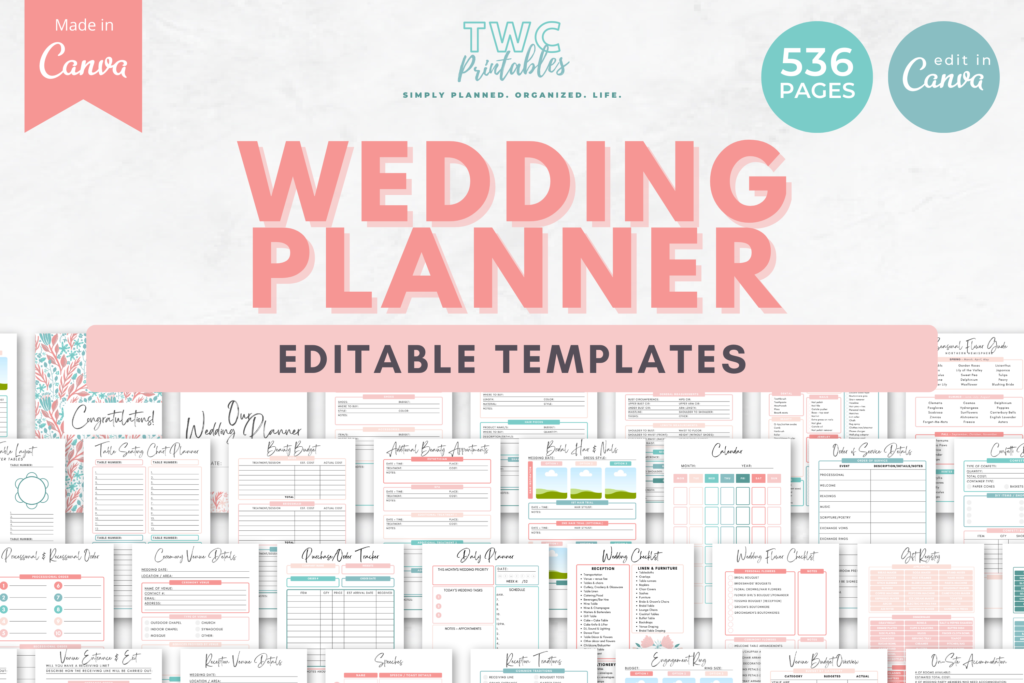Planning a wedding is an exciting journey, one filled with dreams, expectations, and a fair share of challenges. Whether you’re envisioning a small intimate gathering or a grand festive celebration, the key to a stress-free wedding lies in meticulous planning and organization.
From setting your budget to walking down the aisle, this ultimate guide, coupled with the versatile Canva wedding planner, will ensure every detail of your big day is handled with care and creativity.
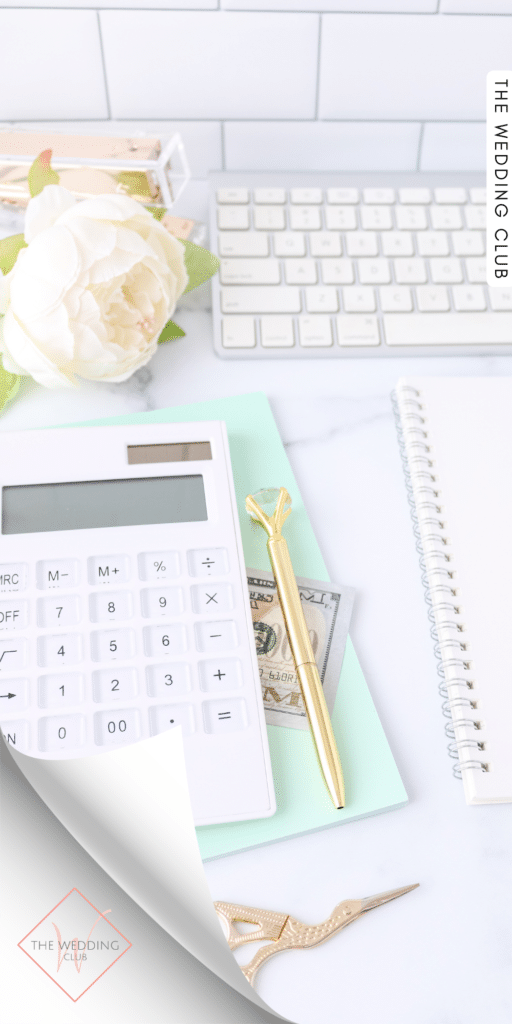
1. Setting Your Wedding Vision and Budget
Planning your dream wedding starts with two essential steps: defining your wedding vision and establishing a realistic budget.
These initial decisions will guide every aspect of your wedding planning process, ensuring that your big day reflects your personal style and stays within financial comfort.
Defining Your Wedding Vision
Explore Inspirations
Begin by gathering inspirations. Whether it’s from wedding magazines, Pinterest, or real weddings you’ve attended, collecting images and themes that speak to you can help crystallize your vision.
Discuss and Dream
Sit down with your partner and discuss each of your dreams for the day. This might include the atmosphere, the setting, size, and key elements like music and decor. Understanding what’s most important to both of you will ensure your wedding day is a reflection of your shared values and tastes.
Consider the Guest Experience
Your wedding vision should also include how you want your guests to feel—whether it’s relaxed, formal, or something uniquely personal. A memorable guest experience often includes thoughtful details that reflect the couple’s story and style.
Setting a Wedding Budget
Estimate Costs Early
Start by researching typical wedding costs in your area to get a baseline.
This includes venue, catering, entertainment, photography, attire, and more. Some online tools like this one from The Knot can help you track these estimates and adjust them as you gather more specific information.
Prioritize Spending
Decide what aspects of your wedding are most important to you. Is it the location, the food, or maybe the photography? Allocating more of your budget to these priority areas means you might need to cut back or get creative with other aspects.
Plan for Unexpected Expenses
Always include a contingency of about 10-15% in your budget for unexpected costs. These might be last-minute tweaks, additional decor, or unforeseen logistical expenses.
Tracking your spending in an editable tool like the Canva wedding planner ensures you can adjust figures on the go, keeping you on track financially.
Stay Organized
Utilize the budgeting pages in the Canva wedding planner to keep a detailed record of all quotes, payments made, and balances due. This real-time tracking is crucial for maintaining control over your finances and ensuring there are no surprises.
By setting a clear vision and a detailed budget early in the planning process, you’re paving the way for a less stressful and more enjoyable journey to your big day.
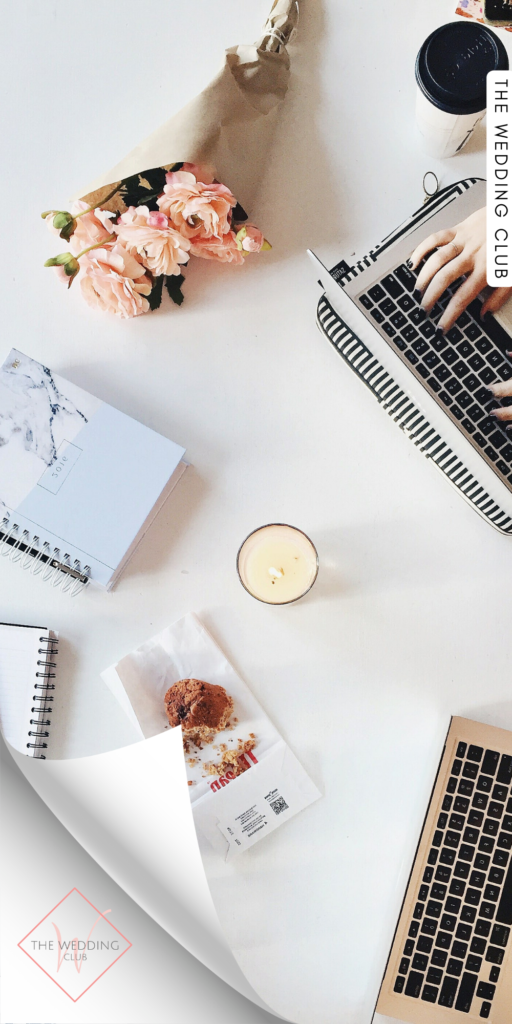
2. The Timeline: From Engagement to Big Day
Organizing a wedding involves myriad details, and keeping track of all the steps can be daunting. A well-defined wedding planning timeline and a comprehensive wedding checklist are indispensable tools that ensure you cover all bases without feeling overwhelmed.
Here’s a strategic approach to planning your milestones from engagement to the big day.
Initial Planning Phase
12-18 Months Out: Setting the Foundations
- Select a Date and Venue: These are the first things you need to lock down because they will influence all other decisions. Venues can book up fast, especially in peak seasons.
- Draft Your Guest List: Knowing the number of guests early on is crucial for selecting the right venue and understanding your catering needs.
- Hire Key Vendors: Photographers, caterers, and planners should be booked early. Use the Canva wedding planner to compare quotes and manage contracts.
9-12 Months Out: Detailing the Big Picture
- Choose Wedding Attire: Begin shopping for dresses, suits, and other attire to ensure sufficient time for fittings and alterations.
- Send Save-the-Dates: Especially important for destination weddings or weddings during busy times, this notice can be crucial for ensuring your loved ones can attend.
Middle Planning Phase
6-9 Months Out: Bringing Your Vision to Life
- Order Invitations: Start designing and ordering your wedding invitations.
- Plan the Menu and Cake Tasting: Work with your caterer to finalize the menu, and schedule cake tastings.
- Book Additional Vendors: Florists, DJs, and other entertainment should be confirmed during this period.
3-6 Months Out: Finalizing the Details
- Purchase Wedding Bands: Ensure this significant task is not left to the last minute.
- Plan Rehearsal Dinner: Start organizing the rehearsal dinner, which is typically the responsibility of the groom’s family.
Final Stretch
1-3 Months Out: Wrapping Up
- Send Invitations: Aim to send these out at least 8 weeks before the wedding.
- Final Fittings: Schedule final fittings for all attire to ensure everything looks perfect.
- Confirm Vendor Details: Finalize times, dates, and expectations with all your vendors.
Week of the Wedding
- Create a Day-Of Itinerary: Distribute the schedule to your wedding party and vendors.
- Pack for Your Honeymoon: Don’t leave this until the last day!
- Relax and Enjoy: Take some time to relax as your big day approaches, trusting that your comprehensive planning has everything under control.
Whether your wedding is 18 months out or you're planning your dream wedding in three months flat, the Canva Wedding Planner can help - with various done-for-you timelines which you can simply print out and use. Nifty!

3. Choosing the Right Vendors
Selecting the right vendors is crucial to bringing your wedding vision to life. The people you choose to work with will have a significant impact on the success of your big day.
From photographers to florists, each vendor plays a pivotal role. This section will guide you through the process of selecting wedding vendors efficiently and effectively, ensuring each choice aligns perfectly with your overall wedding planning goals.
Understanding Your Needs
Define Your Style and Expectations
Before reaching out to potential vendors, it’s important to have a clear idea of the style and quality you expect. Whether it’s the floral arrangements or the type of music, knowing what you want helps in narrowing down the vendor list.
Prioritize Your Budget
Decide which elements of your wedding are most important and allocate your budget accordingly. This will help you determine where to splurge and where to save, guiding your vendor selection process.
Researching and Gathering Options
Ask for Recommendations
Start with friends and family who have recently been married. They can provide firsthand insights and recommendations. Also, wedding forums and social media are great for gathering feedback and experiences from other couples.
Review Portfolios and Testimonials
Examine the work of potential vendors through their portfolios and read through client testimonials. This gives you a sense of their style and the satisfaction level of their previous clients.
Evaluating and Meeting Vendors
Initial Consultations
Arrange meetings or calls with your shortlisted vendors to discuss your vision and their services. This is also a chance to gauge their professionalism and enthusiasm for your wedding.
Compare Quotes and Services
Use the Canva wedding planner to organize and compare quotes and services offered by different vendors. This tool allows you to visually manage your options and make informed decisions.
Making the Decision
Check for Compatibility
Ensure that the vendors you choose are not only talented but also share a good rapport with you. Their willingness to collaborate and their understanding of your vision are crucial.
Review Contracts Carefully
Before signing any contracts, review the details carefully. Ensure that all aspects of the service, including dates, times, costs, and cancellations policies, are clearly noted.
Confirm and Book
Once you’re satisfied, confirm your bookings and keep track of all contracts and receipts in your wedding planner. This centralized documentation will help you manage your commitments and coordinate with vendors as your wedding day approaches.
By meticulously selecting your wedding vendors and using organized tools like the Canva Wedding Planner for managing the process, you can ensure that every aspect of your wedding will be handled by professionals who are committed to making your day special.

4. The Venue: Picking the Perfect Place
Choosing the right venue is one of the most significant decisions in the wedding planning process. The venue sets the tone for the entire event and can influence the décor, timing, and even the choice of vendors.
This section will guide you through the process of wedding venue selection and provide tips to ensure you make the best choice for your special day.
Determining Your Venue Needs
Envision the Event
Start by imagining the type of wedding you want. Is it formal or casual? Indoor or outdoor? The style of your wedding will greatly influence the type of venue you choose.
Guest Considerations
Consider your guest list and the needs of your attendees. If many guests are traveling from out of town, a venue near hotels or within easy transport links might be ideal.
Seasonal Factors
Weather and seasonal changes can affect your venue choice, especially if you’re considering an outdoor event. Think about the time of year and the typical weather conditions when planning.
Researching and Visiting Venues
Start Early
Begin your search early as popular venues can book up quickly, especially during peak wedding seasons. Early booking can also secure better rates.
Use Multiple Sources
Explore various sources such as online wedding directories, social media, and recommendations from recently married friends to find potential venues.
Schedule Visits
Arrange to visit each venue when it’s set up for a wedding to get a realistic feel of what your event could look like. Take notes in your wedding planner during each visit to compare later.
Evaluating Your Options
Assess the Space
Check if the space aligns with your envisioned layout, guest count, and activities. Does it have the right facilities, like audio equipment, seating, and dining areas?
Consider the Costs
Understand what is included in the venue fee. Some venues offer packages that include catering, decorations, and even planning services which might offer savings overall.
Read the Fine Print
Before making a decision, carefully review the contract and cancellation policies. Note any restrictions such as noise ordinances or decoration limitations.
Making the Decision
Compare and Contrast
Use the Canva wedding planner to compare the pros and cons of each venue. This visual tool can help you weigh factors like cost, capacity, amenities, and aesthetics.
Book Your Venue
Once you’ve made your decision, secure your date by signing the contract and paying any necessary deposits. Continue to use your Canva wedding planner to coordinate details specific to the venue, such as floor plans and vendor logistics.
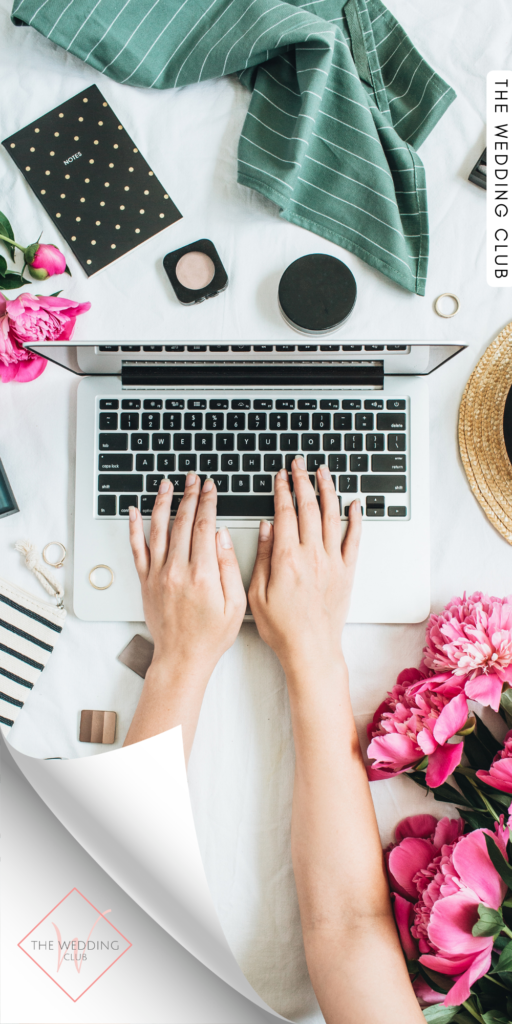
5. Design and Decor: Bringing Your Vision to Life
The design and decor of your wedding are where you can truly make the event your own. It’s about creating an atmosphere that reflects your personality and style, transforming a venue into your dream setting.
Here’s how to effectively plan your wedding decorations and explore creative wedding decor ideas that resonate with your theme.
Establishing Your Design Theme
Define Your Style
Start by defining the overall style or theme of your wedding. Are you aiming for a modern look, a rustic feel, or perhaps something vintage? Pinning down your style will guide all your decor decisions.
Create a Mood Board
Use the Canva wedding planner to create a mood board. Collect images, color swatches, and fabric samples that inspire you and fit your theme. This visual collage will help you maintain a cohesive design.
Choosing Your Elements
Select Key Elements
Identify the key elements that will have the most impact. This could be dramatic lighting, elaborate floral arrangements, or custom table settings. Decide where you want to focus your budget and effort to make the biggest impression.
Integrate Personal Touches
Personalized details such as monogrammed napkins, bespoke signage, or photo displays can make your wedding feel unique. Consider how these elements can be incorporated into your overall decor.
Working with Professionals
Hire the Right Vendors
For elements like floral designs, lighting, and major installations, it’s wise to work with professional vendors. Their expertise can help bring your vision to life with elegance and efficiency.
Collaborative Planning
Involve your vendors in the planning process early. Share your mood board and ideas with them using your wedding planner to ensure everyone understands your vision and can offer creative solutions.
Finalizing Your Decor Plan
Venue Walk-Through
Do a walk-through of your venue with your decorator or designer. Discuss placement, setup, and how to best utilize the space. Use the Canva wedding planner to annotate any venue photos with decor ideas and notes.
Budget Review
Regularly review your decor budget to ensure you’re on track. Having a decent wedding planner in place allows you to adjust allocations as needed, helping you manage finances without sacrificing style.
Detailing Day-Of Coordination
Ensure there’s a detailed plan for decoration setup and breakdown. Coordinate these details in your Canva wedding planner, including timelines and vendor responsibilities.
With careful planning and the help of intuitive tools like the Canva Wedding Planner, your wedding decorations will not only enhance the beauty of your venue but also create an unforgettable atmosphere for you and your guests.
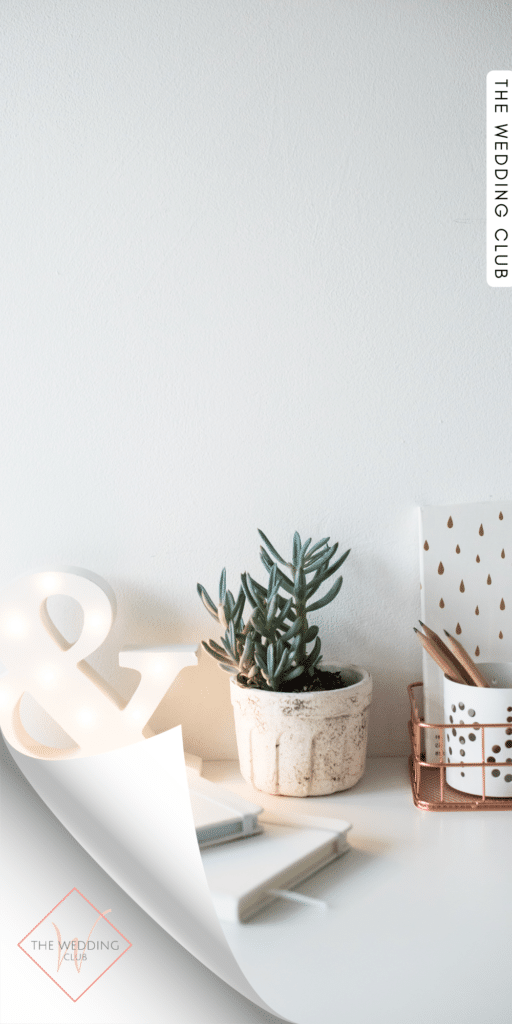
6. The Final Month: Details and Coordination
The final month before your wedding is crucial for tying up loose ends and ensuring everything runs smoothly on your big day.
This phase of final wedding preparations and wedding day coordination requires meticulous attention to detail and clear communication with your vendors and wedding party.
Here’s how to manage this busy time effectively, ensuring that all your planning leads to a perfect wedding day.
Confirming Final Details
Vendor Confirmation
Reach out to all your vendors to confirm details and schedules. Double-check arrangements with your caterers, photographers, florists, and entertainment providers. Your wedding planner can be used to track confirmations and any last-minute changes.
Finalize Guest List and Seating Plan
Confirm your guest list and complete your seating arrangements. Add your finalized seating chart your wedding planner to easily share it with your venue coordinator and caterer.
Review Timelines with Your Wedding Coordinator
Go through the day-of timeline with your wedding coordinator or planner. Ensure there’s a clear understanding of the schedule, from the ceremony to the reception. Adjust your timeline based on these discussions.
Handling Logistics
Wedding Rehearsal
Schedule and conduct your wedding rehearsal. This is essential for making sure everyone involved in the ceremony knows their roles and timings. Use the rehearsal dinner sheets included in the Canva wedding planner to organize a run-through and distribute the schedule to the wedding party.
Pack for Your Wedding Day
Prepare an emergency kit for the wedding day that includes items like safety pins, a sewing kit, extra makeup, and snacks. Also, pack any personal items you’ll need for the day, such as your wedding attire and accessories.
Transportation Coordination
Ensure that transportation for guests, the wedding party, and yourselves is confirmed. Details such as pick-up times, locations, and contact information for drivers should be meticulously planned and recorded in your wedding planner.
Final Touches
Brief Your Vendors
Hold a final meeting or conference call with your vendors to go over the details. Ensure that everyone has a copy of the day’s itinerary to keep all parties synchronized.
Rest and Relax
Despite the busy schedule, make time to relax and take care of yourself. Good rest is crucial to enjoy your big day to the fullest.
Prepare for the Unexpected
Have plans in place for potential last-minute hitches. Whether it’s weather-related or a vendor cancellation, being prepared with alternatives helps mitigate stress.
The last month of wedding preparations is about ensuring all your plans are set and everyone is ready to play their part. Using tools like the Canva Wedding Planner not only helps in keeping these details organized but also ensures seamless communication and coordination, leading to a beautifully orchestrated wedding day.
Frequently Asked Questions about planning your wedding
It's best to start planning at least 12 months in advance. This allows you ample time to book your preferred venue and vendors, and to plan without rushing.
The first step should be to discuss the budget and the scale of the wedding with your partner and possibly your families. Following this, set a tentative date and start looking into venues as they often book up early.
List all expected expenses such as venue, catering, attire, entertainment, and decorations. Allocate funds based on your priorities and always include a contingency fund for unexpected costs. Tools like the Canva wedding planner can help you track your budget effectively.
Use a comprehensive tool like the Canva wedding planner to keep track of appointments, deadlines, budgets, and communications with vendors. It helps you stay organized and ensures that no detail is overlooked.
Research vendors thoroughly, read reviews, and ask for recommendations from recently married friends. Schedule consultations to ensure their vision aligns with yours and always confirm details in writing.
Start by determining the capacity of your venue and your budget. Create a list and categorize guests into must-invite and optional. Use tools like the Canva wedding planner to manage RSVPs and meal preferences.
Consider the location, capacity, availability, cost, and what is included in their package. Make sure the style of the venue aligns with the theme of your wedding and that it has adequate facilities for your guests.
Think about what styles and colors you are naturally drawn to and how they might blend with the season and venue. Use mood boards, like those available in the Canva wedding planner, to visualize and refine your ideas.
Incorporate elements that reflect your interests and relationship, such as custom decorations, personalized vows, or a unique guest book idea. These small touches make the event more memorable and intimate.
Confirm details with all your vendors, go through the day-of timeline with your wedding party, pack for your honeymoon, and try to relax. Double-check everything you’ve planned to ensure a smooth day.
Planning a Wedding?
Save time and effort by grabbing our Wedding Planner Bundle! With over 500+ pages to choose from + edit, we made sure to not leave anything out, giving you peace of mind!

by Tanya Guilfoyle
Born in Johannesburg, South Africa, Tanya has been an active contributor and planner in the wedding industry since 2016. When not writing useful content for brides and wedding professionals, she can be found designing templates for her Etsy shop, TWCprintables.


